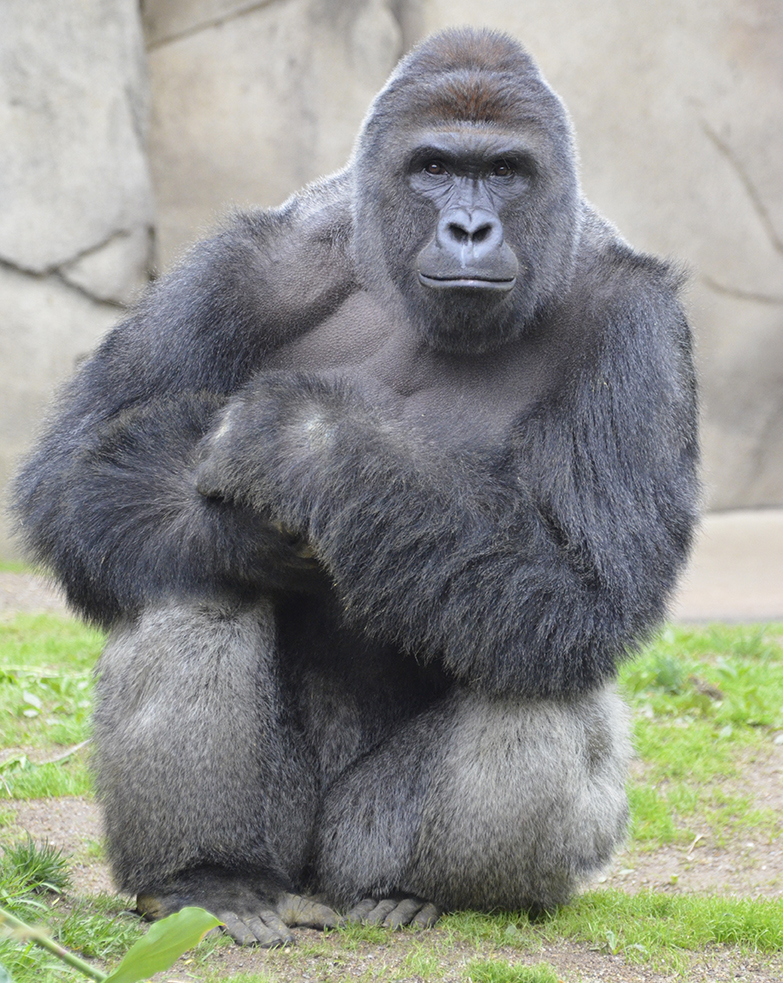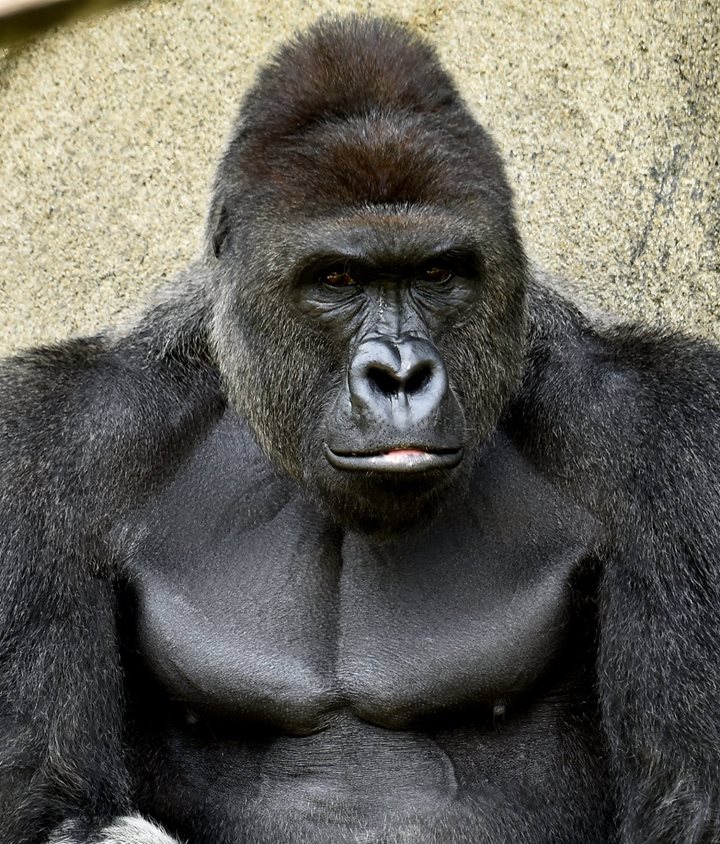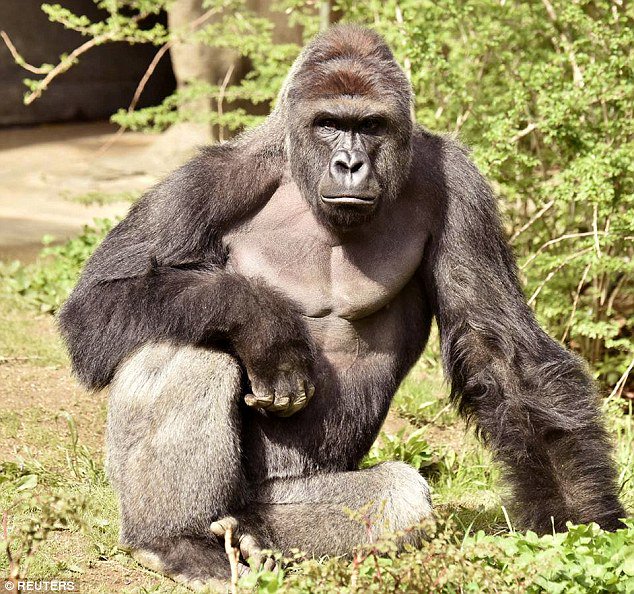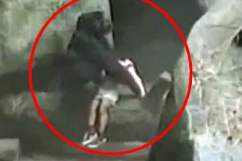
Harambe the gorilla was killed at the Cincinnati Zoo after grabbing a 3-year-old boy who fell into his enclosure. (Cincinnati Zoo)
A 400-pound gorilla was shot dead by an emergency response team at the Cincinnati Zoo on Saturday after he grabbed a 3-year-old boy who had fallen into zoo’s Gorilla World enclosure.
Harambe, a 17-year-old silverback gorilla who celebrated his 17th birthday on May 27, dragged the young boy through a moat inside the enclosure. Zoo officials said in a press release they considered the situation to be “life-threatening” and made the difficult decision to kill the rare gorilla.
“The Zoo security team’s quick response saved the child’s life. We are all devastated that this tragic accident resulted in the death of a critically-endangered gorilla,” Cincinnati Zoo Director Thane Maynard said in a statement. “This is a huge loss for the Zoo family and the gorilla population worldwide.”
The boy had climbed over a barrier and then fell into the moat. The boy’s mother has been identified as Michelle Gregg. She said in a Facebook post on Sunday that “accidents happen” and thanked God for protecting her son. Read more about her here.
The boy’s age was originally reported to be 4, but police said Tuesday he is actually 3. He turns 4 in December.
Here’s what you need to know:
1. Videos Recorded by a Zoo Visitor Show Harambe Dragging the Boy Through the Moat
Videos were posted to Twitter on Saturday by Amber Soler, who said they were recorded by her mother.
The video shows the gorilla grabbing the boy and dragging him into the water. He then stands over the boy for a few moments before bringing him farther into the enclosure.
A woman can be heard in the video shouting, “I’m right here,” and “Please protect him, God, please protect him.”
Kim O’Connor, who recorded video of the incident, said it appeared the gorilla was trying to protect the child.
“I don’t know if the screaming did it or too many people hanging on the edge, if he thought we were coming in, but then he pulled the boy down away further from the big group,” Kim O’Connor told WLWT-TV.
Cincinnati Fire Chief Marc Monahan said in a statement to NBC News that the gorilla was seen “violently dragging and throwing the child.”
He said the gorilla was “neutralized” by a Cincinnati Zoo employe with one shot from a long rifle. The boy was then taken to Cincinnati Children’s Hospital with serious, but not life threatening injuries, officials said.
The boy has been released from the hospital and is going to be OK, according to the Cincinnati Enquirer.
Read more about Harambe in Spanish at AhoraMismo.com:
2. Zoo Officials Say The Boy’s Life Was in Danger & a Tranquilizer Would Have Taken Too Long
Zoo officials said the difficult decision was made to kill the gorilla because the boy’s life was in danger. It was the first time an animal had to be killed at the Cincinnati Zoo.
“The child was not under attack but all sorts of things could happen,” Zoo Director Thane Maynard told CNN. “He certainly was at risk.”
Maynard said a tranquilizer would not have been effective, because it would have taken too long and could have agitated the 400-pound gorilla.
“You don’t hit him and he falls over,” he told CNN. “It takes a few minutes.”
The Gorilla World exhibit has been closed until further notice.
Two other female gorillas had been in the enclosure when the boy fell in, but they were removed safely.
3. Outraged Animal Lovers Have Blamed the Boy’s Parents for Allowing Him to Get Into the Enclosure
Many outraged animal lovers have taken to social media to express outrage toward the boy’s parents, saying they are to blame for Harambe’s death by letting the 3-year-old fall into the enclosure.
“The little boy himself had already been talking about wanting to…get in the water. The mother’s like ‘No, you’re not, you’re not,’” witness Kim O’Connor told the New York Daily News.
A Facebook group, “Justice for Harambe” was created on Sunday. A Change.org petition also calling for justice for the gorilla has garnered more than 10,000 signatures from people calling for the boy’s parents to be held responsible:
We the undersigned want the parents to be held accountable for the lack of supervision and negligence that caused Harambe to lose his life. We the undersigned feel the child’s safety is paramount in this situation. We believe that this negligence may be reflective of the child’s home situation. We the undersigned actively encourage an investigation of the child’s home environment in the interests of protecting the child and his siblings from further incidents of parental negligence that may result in serious bodily harm or even death.
Cincinnati Police have not charged the mother, Michelle Gregg, but said prosecutors could choose to indict her.
The zoo has said it will study the incident and make any necessary changes.
In a statement, the Cincinnati Zoo said, “Gorilla World opened in 1978, and this is the first time there has been a breach. The exhibit is inspected regularly by the Association of Zoos & Aquariums and the United States Department of Agriculture and adheres to safety guidelines.”
Many have said the gorilla should not have been shot, saying it appeared in the video that the gorilla was holding the boy’s hand and comforting him, and not trying to harm him.
Others pointed to videos showing two boys, one in Brookfield, Illinois, and another at the Jersey Zoo in Britain, being protected and rescued by gorillas.
4. Harambe Moved to Cincinnati Zoo in 2014 After Living for Several Years in Texas

Harambe, a 17-year-old gorilla, was shot dead after he grabbed a boy who fell into an enclosure at the Cincinnati Zoo. (Facebook)
Harambe has been at the Cincinnati Zoo since 2014. He was previously at the Gladys Porter Zoo in Brownsville, Texas, according to a Facebook post.
He was raised at the Gladys Porter Zoo from birth by Jerry Stones. The zookeeper told the New York Daily News, “He was a special guy in my life. Harambe was my heart. It’s like losing a member of the family.”
But Stones did not second guess the Cincinnati Zoo’s decision to shoot Harambe.
“I raised him from a baby, he was a sweet cute little guy,” Stones told the Daily News. “He grew up to be a pretty, beautiful male. He was very intelligent. Very, very intelligent. His mind was going constantly. He was just such a sharp character.”
In a post about Harambe shortly after he made his debut in Gorilla World, the Cincinnati Zoo said he was placed in a social group with two 19-year-old females, “Chewie” and “Mara.” The zoo said he was large for his age at 419 pounds.
“At 16, Harambe is a young silverback learning his role as a future leader. He got too old to fit in at his natal institution and, like wild gorillas, had to leave the area to find his own way. Matching him up with the socially-savvy Chewie and Mara is a good step in his development,” Ron Evans, the Cincinnati Zoo’s curator of primates, said. “It’s important to have self-assured females as Harambe transitions from teenager to confident and well-balanced silverback. He demonstrates intelligence and curiosity, using sticks and things to reach for items outside his grasp.”
5. Western Silverback Gorillas Are Considered to be ‘Critically Endangered’ & Harambe’s Death Is a Loss to the Gorilla World, the Zoo Says
Harambe is a Western lowland silverback gorilla, which is considered to be critically endangered, according to the World Wildlife Fund.
He was one of 10 lowland silverback gorillas at the Cincinnati Zoo.
“Harambe was a good guy. He was a youngster, just starting to grow up,” Zoo Director Thane Maynard told the Washington Post. “And there was hopes to breed him. He was not quite of breeding maturity yet. But it’ll be a loss to the gene pool of lowland gorillas.”
There are 765 gorillas in zoos worldwide, along with less than 175,000 in the wild.
“Due primarily to habitat destruction caused by logging, mineral mining and agricultural expansion, wild gorilla numbers continue to shrink,” the Cincinnati Zoo said. “The bushmeat trade – the killing of wild animals to be used as human food – is also a major threat to the western lowland gorilla population throughout the Central African rainforests. More than 1,000 gorillas are illegally poached for the bushmeat trade each year.”





